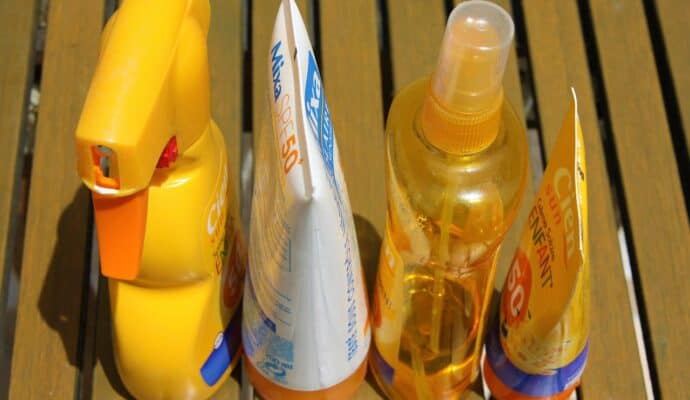Need some tips for wearing sunscreen? Did you know that not every sunscreen is effective – and some are downright harmful? This season, a guide to sunscreens was released just in time for our summer travel plans highlighting what to look for (and what to avoid) when choosing sunscreen. Here’s the scoop including 6 tips for wearing sunscreen when you travel.

Tips for Wearing Sunscreen – Staggering Sunscreen Facts
Here’s a staggering fact regarding sunscreen just in time for summer travel: Today the Environmental Working Group released its 16th annual Guide to Sunscreens, finding that about 75 percent of more than 1,850 products evaluated rate poorly for skin protection from the sun, or have ingredients that could be harmful to health or heighten sensitivity to the sun’s harmful rays.
EWG’s guide rates the safety and efficacy of products advertising sun protection, such as recreational sunscreens, daily-use moisturizers with SPF and lip balms with SPF. Only one out of four products reviewed met the standards for adequate protection and did not contain worrisome ingredients like oxybenzone, a potential hormone-disrupting chemical.
Tips for Wearing Sunscreen – What Are the Best Sunscreens?
The guide’s best-scoring sunscreens contain zinc oxide, titanium dioxide or both, which have fewer health concerns and offer good sun protection. Zinc oxide is stable in the sun, provides protection from UVA and UVB rays, and offers good broad-spectrum protection.
Happily, the guide did find 280 sunscreens met their high standards for quality and effectiveness. My brand of choice? CeraVe.
Tips for Wearing Sunscreen – Keeping Sun Safe
“Sunscreen is an important line of defense from harmful ultraviolet radiation,” said Anat Lebow, M.D., of Lebow Dermatology, in New York. “To protect your skin, remember to reapply sunscreen every couple hours — especially after sweating, swimming or toweling off.
The sun protection factor, or SPF, provides information about how much UV radiation it takes to burn the skin, mostly describing ultraviolet B radiation. I recommend broad-band SPF protection that includes protection against the harmful UVA rays. as well.”
Sunscreen is only one tool in the sun safety toolbox, though. It can help protect the skin from sun damage but should never be a person’s only line of defense.
Proper sun protection includes protective clothing, like a lightweight, long-sleeved shirt, a wide-brimmed hat, sunglasses with UV protection, and shade. For my family, we always pack swim shirts for use at hotels and resorts and wear sunglasses even on cloudy days during a summer getaway. I even grabbed a customized floppy beach hat for relaxing by the pool and walking in the surf.
Tips for Wearing Sunscreen – What Should We Look for In Our Sunscreen?
Keep to these 6 tips to stay safe when outdoors in the sun:
- Avoid products with oxybenzone, which is absorbed through the skin in large amounts and can affect hormone levels.
- Stay away from vitamin A in sunscreens. Government studies link the use of retinyl palmitate, a form of vitamin A, to the formation of skin tumors and lesions when it’s applied to sun-exposed skin.
- Steer clear of sunscreens with SPF values above 50+, which may not give increased UVA protection and can fool people into thinking they’re safe from sun damage. I have to admit, I’m guilty of purchasing the highest SPF I can find, but now knowing this fact I’ll stay at SPF 50 and below.
- Avoid sprays. These popular products make it difficult to apply an adequate and even coating on skin, especially in windy conditions. They also pose inhalation concerns.
- Avoid intense sun exposure during peak hours for sun exposure, between 10 a.m. and 4 p.m.
- Check products against EWG’s Guide to Sunscreens and avoid those with harmful additives.

Leave a Reply